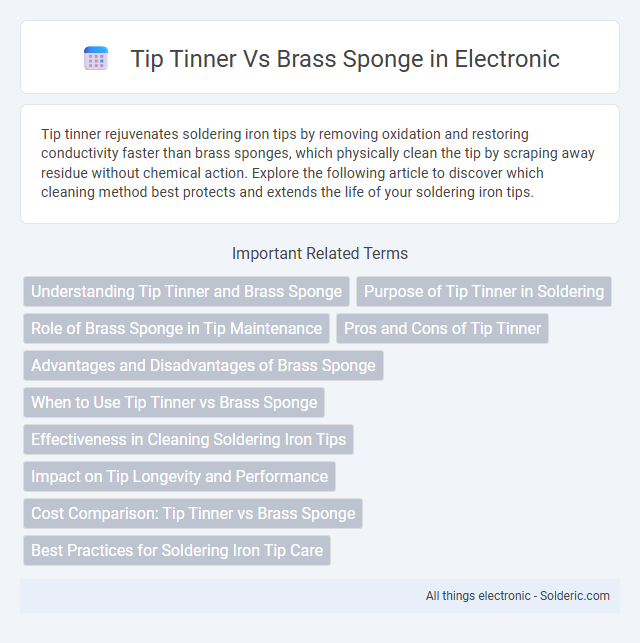Tip tinner rejuvenates soldering iron tips by removing oxidation and restoring conductivity faster than brass sponges, which physically clean the tip by scraping away residue without chemical action. Explore the following article to discover which cleaning method best protects and extends the life of your soldering iron tips.
Comparison Table
| Feature | Tip Tinner | Brass Sponge |
|---|---|---|
| Purpose | Restores oxidized soldering iron tips by re-tinning | Cleans soldering iron tips by removing oxidation and residue |
| Material | Metallic alloy (typically tin and flux) | Brass wire strands |
| Usage | Applied by heating tip and dipping into tinner paste | Tip wiped on brass sponge to clean |
| Cleaning Effect | Allows re-tinning and improves heat transfer | Removes burnt flux and oxidation physically |
| Longevity | Consumable, needs periodic replacement | Durable, lasts longer but eventually wears out |
| Best For | Reviving neglected tips with heavy oxidation | Regular tip cleaning during soldering |
| Impact on Tip Life | Restores coating, prevents tip damage | Gentle on tip, prevents scratches unlike wet sponges |
Understanding Tip Tinner and Brass Sponge
Tip tinner and brass sponges serve distinct purposes in soldering tip maintenance, with tip tinner composed of flux and solder to restore oxidation and improve heat transfer. Brass sponges clean tips by physically removing oxidation and residue without water, preserving soldering temperature and prolonging tip life. Choosing between tip tinner and brass sponge depends on whether restoring solderability or regular cleaning is required for optimal soldering performance.
Purpose of Tip Tinner in Soldering
Tip tinner helps to restore and maintain the soldering iron tip's efficiency by removing oxidation and re-coating it with fresh solder. Unlike brass sponges, which physically clean debris without chemicals, tip tinner chemically revitalizes the tip surface, improving heat transfer and solder adherence. Regular use of tip tinner extends the tip's lifespan and ensures consistent soldering quality in electronic assembly.
Role of Brass Sponge in Tip Maintenance
Brass sponge plays a crucial role in tip maintenance by effectively cleaning soldering iron tips without causing thermal shock or wearing down the tip surface. Unlike traditional wet sponges, brass sponges remove oxidation and residue while preserving the tip's thermal conductivity and longevity. Using a brass sponge ensures your soldering tips remain in optimal condition for precise and consistent soldering performance.
Pros and Cons of Tip Tinner
Tip tinner effectively restores soldering iron tips by removing oxidation and improving heat transfer, making your soldering work more efficient. It is quick and easy to use but can wear down the tip's plating over time, potentially reducing tip lifespan. Unlike brass sponges, which clean without chemicals or abrasion, tip tinner provides deeper restoration but requires careful application to avoid damage.
Advantages and Disadvantages of Brass Sponge
Brass sponges offer effective tip cleaning by removing oxidation and residue without damaging the soldering tip's protective coating, prolonging its lifespan compared to abrasive alternatives like tip tinner. They provide quick, reusable cleaning without requiring chemicals, but can accumulate debris over time and may be less effective on heavily oxidized tips. Your choice between brass sponges and tip tinners depends on whether you prioritize long-term tip protection or aggressive residue removal.
When to Use Tip Tinner vs Brass Sponge
Tip tinner is ideal for restoring oxidized soldering iron tips by removing corrosion and replenishing the tip's metal surface, enhancing heat transfer and prolonging tool life. A brass sponge is best suited for routine cleaning during soldering sessions as it effectively removes solder residues without cooling the tip, maintaining consistent temperature and solder joint quality. Use tip tinner for occasional deep cleaning when the tip becomes dull or coated with tough oxidation, and rely on a brass sponge for regular maintenance between solder joints.
Effectiveness in Cleaning Soldering Iron Tips
Tip tinner is highly effective in cleaning soldering iron tips by restoring the tip's surface through a combination of flux and metal alloy, which removes oxidation and re-tins the tip, improving thermal conductivity. Brass sponges mechanically remove excess solder and residue without causing thermal shock or quick cooling, extending tip lifespan while maintaining cleanliness. Both tools enhance tip performance, but tip tinner provides deeper restoration, whereas brass sponges offer safer, real-time cleaning during soldering.
Impact on Tip Longevity and Performance
Tip tinner restores soldering iron tips by removing oxidation and adding a fresh layer of solder, effectively extending tip longevity and ensuring consistent thermal performance. In contrast, a brass sponge cleans tips mechanically without removing solder, preserving tip shape but offering less restoration of thermal conductivity. Regular use of tip tinner can significantly improve solder wettability and reduce tip replacement frequency, while brass sponges are ideal for daily cleaning to maintain optimal solder flow.
Cost Comparison: Tip Tinner vs Brass Sponge
Tip tinner is generally more cost-effective for maintaining soldering iron tips, as it typically requires less frequent replacement compared to brass sponges. Brass sponges, while initially inexpensive, wear out faster and may need to be replaced more often, increasing long-term costs. Evaluating both options, tip tinner offers a budget-friendly solution for prolonging tip life and maintaining optimal soldering performance.
Best Practices for Soldering Iron Tip Care
Using tip tinner effectively restores oxidized soldering iron tips by removing contaminants and refreshing the solder coating, which extends tip lifespan and improves heat transfer. Brass sponges clean solder residues without abrading the tip surface, preserving tip integrity and ensuring consistent soldering performance. Regularly alternating between tip tinner and brass sponge enhances tip care, preventing oxidation and mechanical damage for optimal soldering results.
Tip tinner vs brass sponge Infographic

 solderic.com
solderic.com